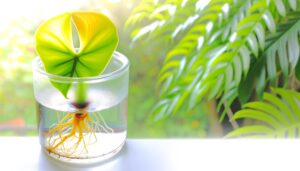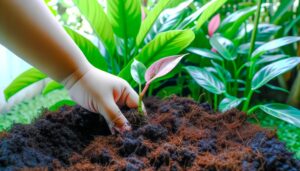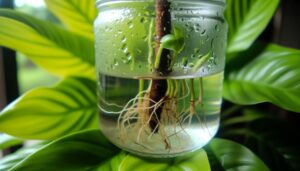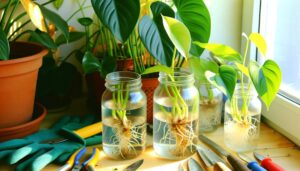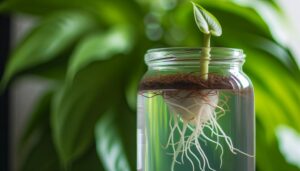Blushing Philodendron Propagation: Easy Methods and Tips!
Blushing Philodendron propagation is best done in spring or early summer when conditions support active growth. Utilize sterile pruning shears to cut a 4-6 inch stem with multiple nodes and at least two leaves.
Methods include stem cutting, water propagation, and air layering. Maintain high humidity and indirect light to promote root development.
Keep propagation medium like peat moss and perlite moist but not waterlogged. Use rooting hormone to stimulate root growth and protect cuttings from direct sunlight.
Regularly monitor for pests and diseases. Ensuring ideal conditions will substantially increase your success rates; further details can enhance your propagation endeavors.
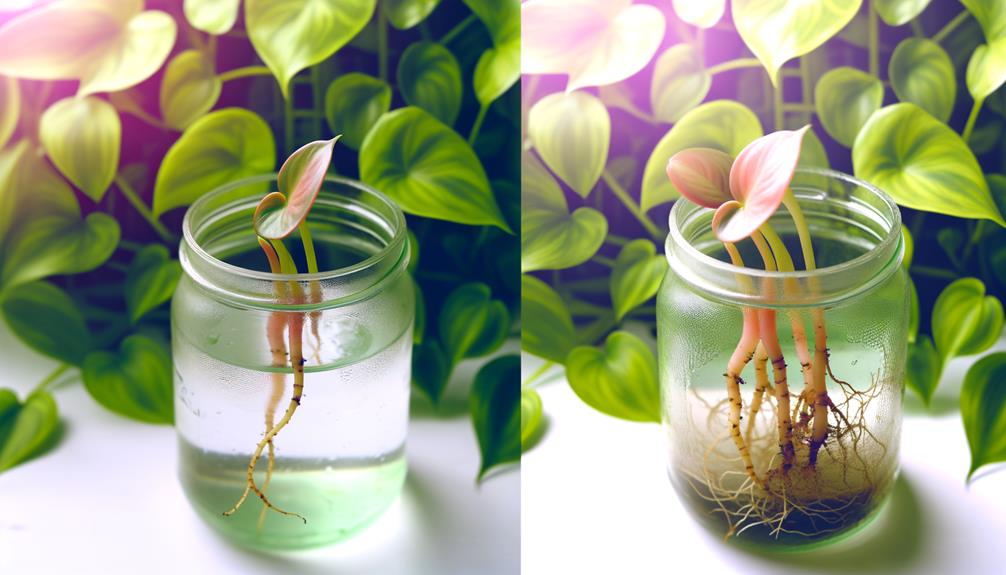
Key Takeaways
- Spring and early summer are ideal for propagating Blushing Philodendron.
- Use sterilized pruning shears to take 4-6 inch stem cuttings with multiple nodes.
- Maintain high humidity and warm, indirect light for successful root development.
- Water propagation involves placing the stem in water until roots form.
- Regularly check cuttings for pests and diseases to ensure healthy growth.
Understanding Blushing Philodendron
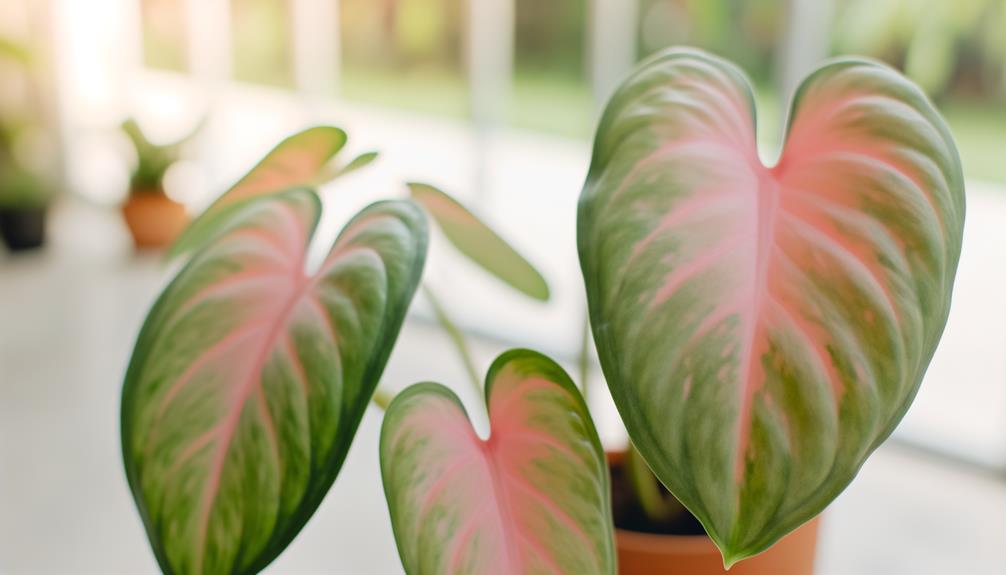
The Blushing Philodendron (Philodendron erubescens) is a perennial climbing plant known for its striking red stems and lush, dark green foliage. Native to the tropical regions of South America, this species thrives in humid, warm environments. Its heart-shaped leaves can grow up to 12 inches long, providing a dramatic aesthetic appeal.
The climbing habit of Philodendron erubescens allows it to ascend vertical structures, making it a popular choice for indoor and outdoor decoration. It exhibits an epiphytic growth pattern, using aerial roots to cling onto surfaces. The plant prefers well-draining soil and indirect, bright light to ensure the best growth.
Understanding its natural habitat and physiological needs is essential for successful cultivation and propagation.
Best Time for Propagation
The best time for propagating Blushing Philodendron is during the spring and early summer months, when environmental conditions are most favorable. These periods provide ideal warmth and light, which stimulate vigorous growth and root development.
Additionally, selecting plants in their active growth phase guarantees higher success rates and healthier offspring.
Optimal Seasonal Conditions
During the spring and early summer months, blushing philodendron propagation is most successful due to ideal temperature and humidity conditions. These months provide the best balance of warmth and moisture, which are essential for root development and overall plant health.
Temperature ranges between 70°F to 80°F (21°C to 27°C) promote vigorous growth, while humidity levels of 60-80% prevent desiccation of the cuttings. Additionally, increased daylight hours during this period enhance photosynthesis, further supporting the energy needs of the developing cuttings.
It is important to avoid extreme temperature fluctuations and maintain consistent moisture levels in the growing medium. This guarantees that the cuttings remain stable and receive the necessary conditions to foster robust root and shoot formation.
Growth Phase Timing
Importantly, timing the propagation of blushing philodendron to align with its natural growth phases enhances the success rate and vigor of new plants.
Optimum propagation is best achieved during the plant’s active growing season, typically in spring or early summer. During this period, the plant exhibits robust growth and higher metabolic activity, which fosters root development and acclimatization.
Key considerations include:
- Early Spring: The onset of new growth makes this an ideal time.
- Mid-Spring: Continued active growth supports successful cuttings.
- Early Summer: Warm temperatures and increased light intensity favor rooting.
- Avoiding Dormancy: Late fall and winter are not recommended due to reduced metabolic activity.
Necessary Tools and Materials
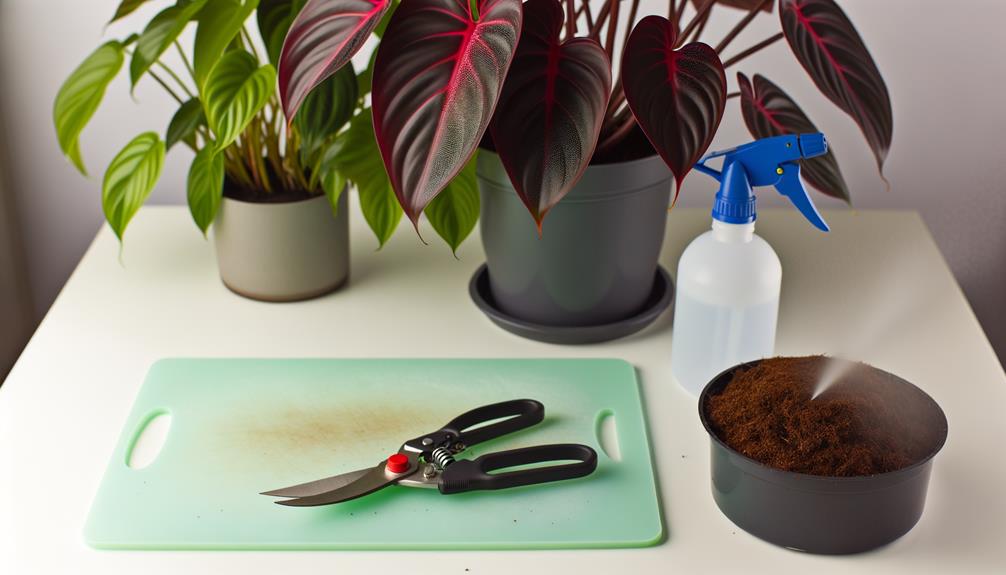
A successful spread of a Blushing Philodendron requires specific tools and materials to promote plant health and growth. Essential items include a pair of sterilized, sharp pruning shears for making clean cuts, minimizing tissue damage and infection risk.
A suitable spread medium, such as a mix of peat moss and perlite, guarantees proper aeration and moisture retention. Clean containers with drainage holes are necessary to prevent waterlogging. Rooting hormone can be applied to cuttings to stimulate root development.
Additionally, transparent plastic bags or domes help maintain humidity levels, critical for root formation. Finally, a spray bottle with distilled water aids in maintaining moisture without over-saturating the medium, ensuring ideal conditions for successful spread.
Selecting Healthy Cuttings
Selecting healthy cuttings is vital for the successful propagation of Blushing Philodendron, necessitating careful examination of the parent plant for disease-free, robust stems with multiple nodes.
Prioritize stems that exhibit vigorous growth and are free from any signs of pest infestation or fungal infections. The chosen cuttings should ideally be 4-6 inches long and include at least two to three healthy leaves.
To achieve the best selection, follow these steps:
- Inspect the parent plant thoroughly for any signs of disease or stress.
- Choose stems with a minimum of two nodes, as nodes are important for root development.
- Avoid selecting overly mature or woody stems, as they may root less readily.
- Ensure the cutting has at least two healthy leaves to support photosynthesis during root formation.
This meticulous selection process enhances propagation success.
Water Propagation Method
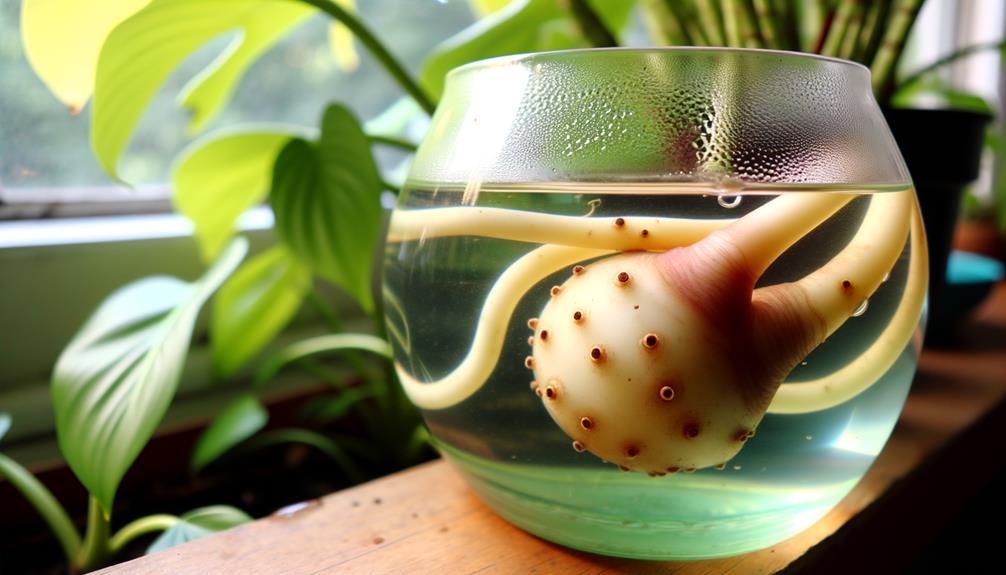
After selecting healthy cuttings, the next step in propagating Blushing Philodendron is to utilize the water propagation method, which facilitates root development and allows for easy monitoring of progress.
Begin by placing the cuttings in a transparent container filled with clean, room-temperature water, ensuring that at least one node is submerged. Position the container in a location with indirect sunlight, as direct sunlight can cause algae growth and damage to the cuttings.
Change the water every few days to prevent bacterial buildup and to provide fresh nutrients. Within a few weeks, roots should begin to emerge.
Once the roots reach a length of approximately two inches, the cuttings are ready for the next stage of propagation.
Soil Propagation Method
For successful soil propagation of Blushing Philodendron, make sure that cuttings are planted in a well-draining potting mix to promote healthy root development and prevent waterlogging.
Follow these steps:
- Select Healthy Cuttings: Choose cuttings with at least one node and a few leaves to guarantee optimal growth potential.
- Prepare the Potting Mix: Utilize a mix comprising equal parts of perlite, peat moss, and pine bark to create an aerated and well-draining environment.
- Plant the Cuttings: Insert the cuttings into the potting mix, ensuring the node is buried, and the leaves are above the soil surface.
- Maintain Moisture Levels: Keep the soil consistently moist but not saturated, to avoid root rot and encourage root formation.
This method guarantees robust root development and plant health.
Caring for New Plants
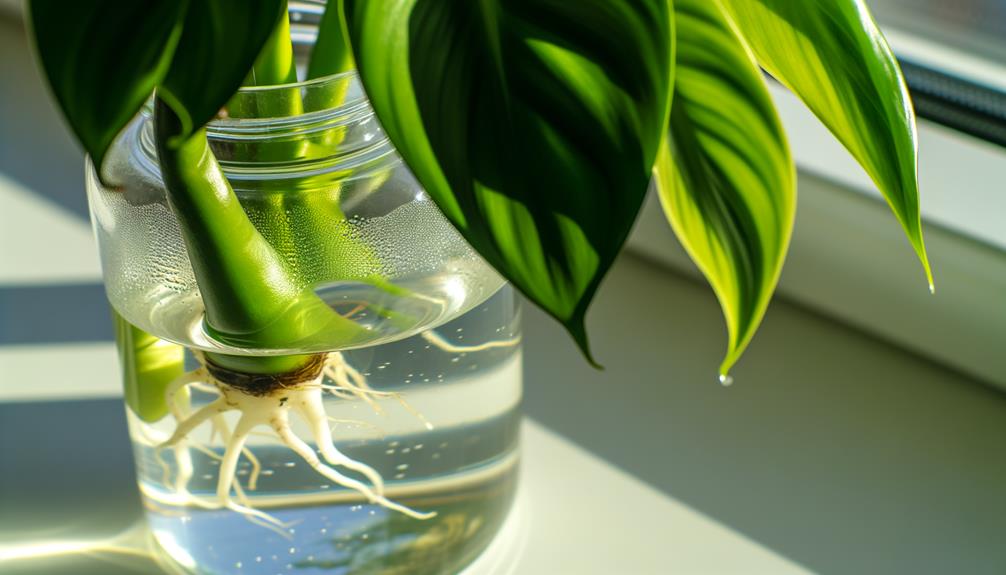
To safeguard the continued health and significance of newly propagated Blushing Philodendrons, meticulous attention to their care is crucial. Newly rooted plants require prime light, consistent moisture, and appropriate humidity levels to thrive.
Place the plants in bright, indirect sunlight to prevent leaf burn. Maintain soil moisture by watering when the top inch becomes dry, and optimize proper drainage to avoid root rot. Humidity should be kept between 60-70%, mimicking their native tropical environment.
| Care Aspect | Recommendation |
|---|---|
| Light | Bright, indirect sunlight |
| Watering | When top inch of soil is dry |
| Humidity | 60-70% |
Such precision in care cultivates robust growth and vibrant foliage, promoting the philodendron’s successful establishment.
Troubleshooting Common Issues
Identifying and addressing common issues in Blushing Philodendron propagation is crucial to secure the plant’s long-term health and vigor.
The following are common problems and their solutions:
- Root Rot: Often caused by overwatering or poor drainage. Guarantee well-draining soil and reduce watering frequency.
- Yellow Leaves: Typically results from insufficient light. Place the plant in bright, indirect light to resolve this issue.
- Pest Infestation: Regularly inspect for pests like spider mites or aphids. Treat with insecticidal soap or neem oil as needed.
- Slow Growth: May be due to nutrient deficiencies. Utilize a balanced, water-soluble fertilizer during the growing season to promote healthy growth.
Addressing these issues promptly will support robust growth and thriving Blushing Philodendrons.
Conclusion
The propagation of the Blushing Philodendron requires meticulous attention and precise care. It is not merely a horticultural task but an intricate botanical ballet. Mastery of timing, selection of robust cuttings, and the precise execution of propagation methods are paramount.
Ensuring ideal conditions for nascent plants and adeptly addressing potential issues transform this process into a veritable symphony of plant cultivation. This promises not just success but botanical triumph.

